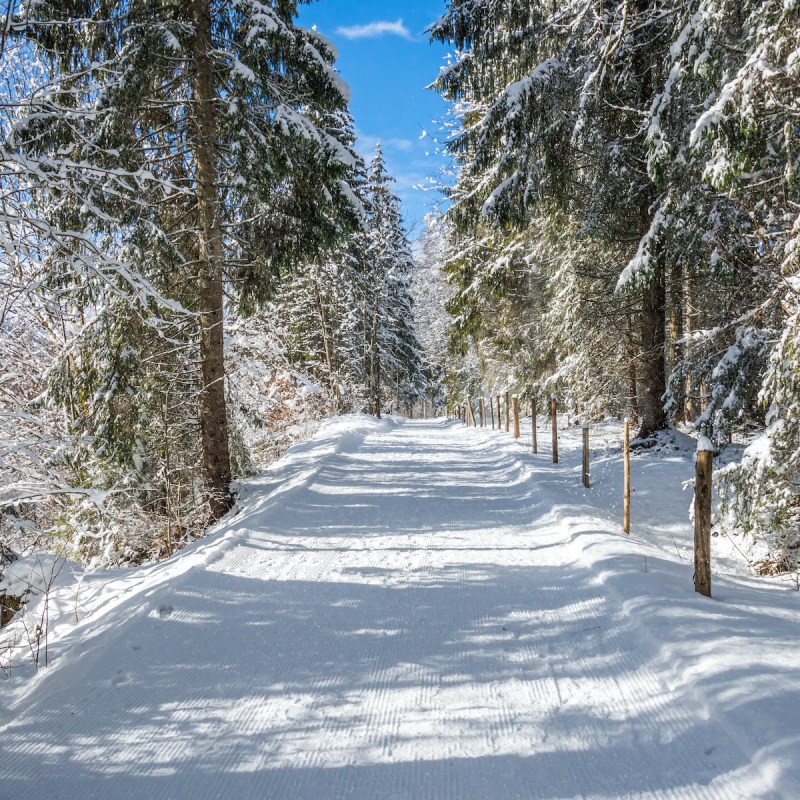
There are many reasons to go hiking in winter. It is a magical season on the trail when the leaves have fallen and landscapes that are normally unseen on your favorite hike suddenly surround you, and with a light covering of snow, the trail is still and silent, most likely a new experience for your senses.
Videos by TravelAwaits
Winter is an amazing season for hiking, but you have to be prepared for it. It can be either a magical experience or misery. Here are eight tips, in no particular order of importance, to keep you safe and warm when winter hiking.
While this list is basically for day hiking, many of these tips can also be used for overnight winter backpacking; just remember that there is much more to know before doing an overnight trek in winter. That’s a list for another day.

1. Dress In Layers
Some people call it “dressing like an onion.” That’s exactly what dressing in layers is all about and it is probably the single most important tip for winter hiking.
As you walk the trail, temperatures will vary greatly. Dressing in layers allows you to remove or add a layer in order to help you regulate your body temperature.
You should wear three layers: The base layer that wicks sweat off your body, the middle or insulating layer to retain body heat, and the outer layer that protects you from wind and rain. These basic categories can be broken down further into the different types of weather you may encounter, from cold, wet days to sunny and warm, almost springlike days. A good reference for these subcategories of layers can be found on the REI Layering Basics website.
Clothing is not the place to try and cut costs. Don’t scrimp on the quality of the clothing you wear. It makes an enormous difference.
2. Bring Other Clothing Necessities
We can’t forget your extremities. Your toes and feet are always the first to be affected by the cold. Always wear heavyweight winter hiking socks. Carry with you two pairs of gloves (one set may get wet, especially in the snow.) And don’t forget to wear a winter cap.
Just as important as socks are the hiking boots you wear. Boots should be insulated and waterproof. Make sure the boots say “waterproof” on the box. Some will be labeled “water resistant.” They are not the same. The best boots for winter weather have rubberized or synthetic lowers. These are guaranteed to not absorb water.
Some manufacturers provide temperature ratings for boots, but in reality, there is really no sure way to estimate this; it’s subjective. Every person is different — their activity level, health, weight, etc. Still, the ratings are a reasonable estimate as to the relative warmth of a boot.
Finally, if you are hiking in the snow, wear those sunglasses or goggles. Even the smallest amount of snow can cause vision issues.

3. Be Weather-Wise
Weather forecasts have become very dependable. Before you drive off to that trailhead, get the latest forecast from the National Weather Service or reliable online weather services such as the Weather Channel, AccuWeather, or local media outlets in the area where you plan on hiking.
When checking the weather, don’t just look at the forecast for the entire day. Drill down into the hourly forecast. A daily forecast may say there is a 50 percent chance of rain, but that may be only at certain times of the day.
Also take into account the wind speed and direction to dress accordingly as well as the times for sunrise and sunset. It’s easy to forget that the sun sets earlier in winter, and you don’t want to be caught on the trail after dark.

4. Never Hike Alone
This is a touchy subject for some people. They love to hike solo, but it’s really not a good idea any time of year, especially in winter. It’s definitely more fun to hike with friends, but more importantly, it all comes down to safety.
If you experience an injury, hypothermia, or any number of injuries or health issues, your hiking partner can help you off the trail and get help in a timely manner.

And speaking of safety, it’s always good to let someone who is not in your hiking party know your plans. Let them know where you plan to hike and when you can be expected to return home. If there is a register at the trailhead, be sure to complete it so that in the event of an emergency, park rangers will know that you are out on the trail.

5. Carry The Hiking Essentials
Map, Compass, GPS
It’s always a good idea to bring along a GPS to track your movements and locate where you are — but remember, wintry weather drains batteries fast. Carry extras.
Don’t rely on phones for GPS tracking on the trail. You never know where you will lose signal and again, and batteries can drain rapidly.
You should take along a paper map and compass as a backup and know how to use them. It’s called orienteering and can be a hiker’s best friend.
Water And Purifying Method
We’ll talk about how it is even more important to keep hydrated when winter hiking in a moment. Just be sure to carry plenty of water and a method to filter water if you need to from streams and lakes.
Food
Winter hiking causes your body to burn thousands more calories than hiking in milder temperatures. Making sure you have plenty to eat on the trail is important not only for energy, but also helps to keep you warm.
Bring along lunches and snacks that are high in protein, fat, and calories. Trail mix and granola bars are best for snacks. The nuts, dried fruit, and oats cover all of your needs.
And don’t be shy. Bring along that sealed thermos or mug of hot soup, tea, or cocoa.
Matches And Fire Starter
In case of emergencies, a small fire can be invaluable. Bring along the waterproof matches and either a store-bought or homemade fire starter to get that fire going so you won’t be trying to rub wet sticks together.
First Aid Kit
A basic first aid kit is essential no matter what time of year you hike. You don’t need a fancy store-bought kit. You can piece one together yourself just have a basic knowledge of how to use what you bring with you. Consider adding a small waterproof first-aid guide to your kit.
Knife Or Multi-Tool
You will be surprised how many uses there are for a small knife or multi-tool on the trail for both emergency and non-emergencies. That pack of trail mix may say it has an “easy open pouch” — that is, until you try to open it.
Sun Protection
The sun can be brutal in winter, especially if you are hiking in snow. Wear sunglasses and don’t forget sunscreen.
Space Blanket
Small and inexpensive, space blankets can mean the difference between life and death if you are stranded on the trail for whatever reason. They can provide additional warmth or be used as a rain shelter.
6. Stay Hydrated
Earlier I mentioned the need to drink plenty of water when hiking, especially in winter. During the winter months, your body has to work extra hard to keep your core temperature up.
The general rule is two cups per hour of hiking for adults, and one to two cups for children. But that’s the base. Increase the amount accordingly. If you will be hiking near streams, creeks, or lakes, pack along a water filter or other purification methods so you can get drinking water from these sources and help lighten the load you carry.
7. Learn The Warning Signs Of Hypothermia
Hypothermia occurs when your body is exposed to cold temperatures for a prolonged period of time. But it doesn’t have to be freezing temperatures that can cause hypothermia. In fact, it can occur at temperatures above 40 degrees if you become chilled from rain or sweat.
Get off the trail as quickly as possible and seek help if you see any of these warning signs:
- Shivering
- Memory loss
- Exhaustion or fatigue
- Slurred speech
- Drowsiness
- Confusion
- Fumbling hands
For information on treating a person with hypothermia, visit the CDC’s hypothermia website.

8. Start Small, Start Early, And Know When To Call It Quits
The best advice for having a safe — and warm — winter hike is to take shorter hikes than you normally would on a pleasant spring day. Start early in the morning, and know when to call it quits.
It’s easy to find yourself enjoying the hike and then realize you are getting extremely cold or it’s getting late in the day and the sun will be setting soon.
Keep an eye on the time and listen to what your body is telling you and know when it’s time to head home.
